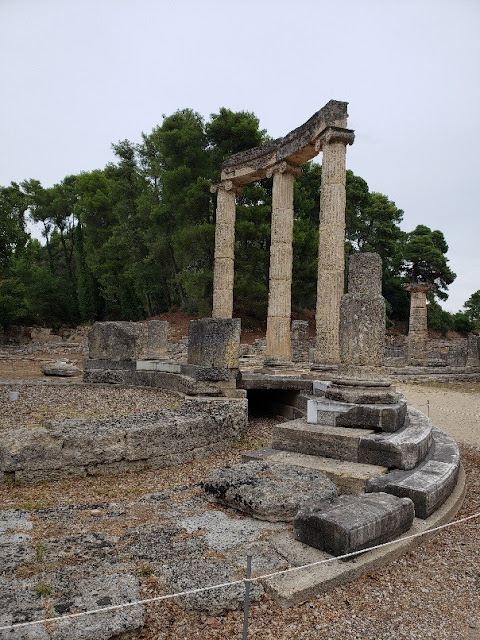We docked in Katakolon this morning under cloudy skies. I had booked a tour of Olympia so headed off the ship at 0830 to board the bus. As with many things aboard ship, the excursion experience is a lot smoother. In years past, if you desired to book a tour, you'd visit the Tours Desk, pay your money and get a receipt. The tour group would assemble at a designated time and spot and the coordinator would call names and give out tickets. At the appointed time, the group would be called and make its way down the gangway to the bus. Now you book your reservation on line, show up at the designated time and location, show your digital reservation, get a tour sticker for your chest and head for the bus.
We rode about 20 minutes to the site of Olympic excavations and started walking. One of the reasons Iko decided not to go on this tour was the advertised walking. And the advertisement was right. According to my Pacer app, we walked four plus miles. Mostly slowly with many stops for narration by our guide.
The first stop was the archeological excavation area where the original Olympic games were held every four years from the 8th century BC to the 4th century AD. Around the end of that period, earthquakes, floods and tsunamis, along with invading tribes and official edicts, brought the Olympics to an end and the majestic Olympic buildings and stadiums down and buried under mud and sand until the mid to late 1770's. From then there have been various excavations by various people with various motives. Prime pieces of sculpture were removed to other countries and interest in the excavations waxed and waned until around 1876 when major works were undertaken. If you are interested in reading about the history of the games and the excavations, I recommend Wikipedia: https://en.wikipedia.org/wiki/Olympia,_Greece
The excavated ruins are impressive. At times I could visualize the ancient buildings and games.
Our guide handed out "Whisper" devices at the start of our wanderings. Even for a hearing challenged person like me they were very effective and consist of an earpiece on a lanyard. The earpiece is not inserted but, held by a loop over the ear, sits on the outside of the ear and uses a small speaker to broadcast the guide's words. It meshed nicely with my hearing aid. The battery is in the earpiece so it's a little more handy than the ones we used at the Athens museum, which had a battery pack attached to the earpiece by a wire. Here Angelica is reciting from her vast store of local knowledge.No matter where we looked there were ruins.On one pathway I was following a well-equipped walker. Most of his pack was the usual, but the hand sanitizer caught my eye.The local Olympia olives ar not so good for eating but are noted for their oil with acidity in the 0.02% range. Many, including our guide, consider it the best olive oil in Greece.
Next stop was the Archeological Museum which contained many smaller artifacts that have been found during the excavations.
Influential people who could afford to, brought horses, sheep and goats to be sacrificed at the appointed times at the Temple of Zeus. These small brass animal figures were presented to the Deities by the ordinary people who could not afford to give live animals.
There were many amazing displays of artifacts, both in this museum and the other one we visited. I took too many photos and had to strictly ration myself on what I could post to this entry for fear of having your eyes glaze over. Hermes is one of the most famous statues on display.
About 1330 we stopped at a restaurant for a nice Greek meal.I think this entry is large enough, so I'll continue our Wednesday adventure in the next post, in which I look around the natural artifacts of the area.











Very interesting, that was alot of walking right enough
ReplyDeleteSome great photos